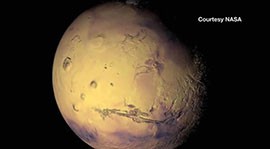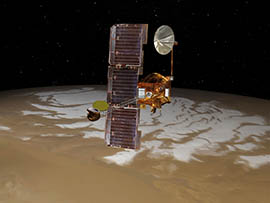Cronkite News has moved to a new home at cronkitenews.azpbs.org. Use this site to search archives from 2011 to May 2015. You can search the new site for current stories.
ASU camera helps NASA pick out site for next Mars lander
TEMPE – From the Viking landers in the 1970s to the most recent Curiosity rover, machines have acted as scientists’ eyes on Mars.
And in 2016, NASA will send another lander, called InSight, that will study the red planet’s interior and seek answers about the formation of rocky planets.
But first, NASA had to figure out a safe place to land – and that’s where Arizona State University’s School of Earth and Space Exploration comes in.
About 40 faculty members and graduate students here manage the thermal emission imaging system, or THEMIS, an infrared camera attached to the orbiting Mars Odyssey spacecraft, which launched 13 years ago.
“Space exploration is critical to humankind on a number of different levels, and that makes it such a worthwhile thing for a university to pursue,” said Lindy Elkins-Tanton, a foundation professor and director of the School of Earth and Space Exploration. “The first thing is just inspiration, the wish for humankind to be explorers, and the invitation that we therefore issue tacitly to students to get involved with and think about what lies beyond the Earth.”
Jonathan Hill, a mission planner and graduate student, operates the camera, telling it where and when to take photos. THEMIS is also helping scientists understand what the surface is made out of – from the famous orange sands and dust to solid rock to any possible abnormalities.
“(NASA) had to find an area that had a lot of exposed rock, but not a lot of boulders on the surface, because the lander could land on one and tip over. But it also can’t land in any areas that have too much dust or dirt on the surface,” Hill said. “An infrared camera is uniquely sort of tweaked and tuned in to find those kind of areas.”
Christopher Edwards, a research physical scientist with the U.S. Geological Survey whose emphasis is on Mars studies, worked on THEMIS during his five years as a graduate student at ASU. He said the InSight lander aided by THEMIS has a seismometer on it as well as a temperature heat flow probe.
“The idea is it’s trying to look at how active Mars is from a tectonic perspective,” Edwards said. “It’s also trying to look at the structure of Mars. These measurements will help us understand the interior of Mars and how planets form and how they change over time in a way that we’ve never done before.”
THEMIS was designed by Phil Christensen, a professor at ASU. It was built at the university by a small group of engineers from ASU and Raytheon.
“Dr. Christensen has also designed a lot of other infrared instruments for NASA and so when they decided they wanted an infrared imager, he was sort of an obvious choice,” Hill said.
Hill said ASU will continue to be part of the InSight group, monitoring from above things like dust in the area. For example, if there’s too much dust blowing around it could obstruct the solar panels on the lander, potentially endangering the mission.
The team is also looking into using the camera to pick out a landing spot for another Mars lander planned for 2020. Everything that has landed on Mars since THEMIS was launched has been helped by the camera.
“I think finding out whether life is a fundamental process or not is inherently important,” Hill said. “Is it something that is rare or is it something that is sort of a natural part of the evolution of a solar system?”










